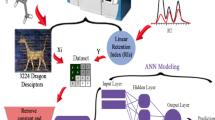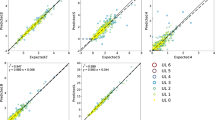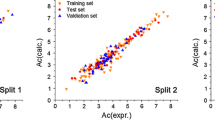Abstract
In this work, the vapor pressure of pesticides is employed as an indicator of their volatility potential. Quantitative Structure-Property Relationship models are established to predict the classification of compounds according to their volatility, into the high and low binary classes separated by the 1-mPa limit. A large dataset of 1005 structurally diverse pesticides with known experimental vapor pressure data at 20 °C is compiled from the publicly available Pesticide Properties DataBase (PPDB) and used for model development. The freely available PaDEL-Descriptor and ISIDA/Fragmentor molecular descriptor programs provide a large number of 19,947 non-conformational molecular descriptors that are analyzed through multivariable linear regressions and the Replacement Method technique. Through the selection of appropriate molecular descriptors of the substructure fragment type and the use of different standard classification metrics of model’s quality, the classification of the structure-property relationship achieves acceptable results for discerning between the high and low volatility classes. Finally, an application of the obtained QSPR model is performed to predict the classes for 504 pesticides not having experimentally measured vapor pressures.

Similar content being viewed by others
References
Abraham MH, Acree WE Jr (2020) Estimation of vapor pressures of liquid and solid organic and organometallic compounds at 298.15 K. Fluid Phase Equilib 519:112595
ACDLabs/ChemSketch (2023) https://www.acdlabs.com/. Accessed March 2023
Aranda JF, Bacelo DE, Leguizamón Aparicio MS, Ocsachoque MA, Castro EA, Duchowicz PR (2017) Predicting the bioconcentration factor through a conformation-independent QSPR study. SAR&QSAR Environ Res 28(9):749–763
Ballabio D, Grisoni F, Todeschini R (2018) Multivariate comparison of classification performance measures. Chemom Intell Lab Syst 174:33–44
Banerjee A, Roy K (2023) Prediction-inspired intelligent training for the development of Classification Read-across Structure-Activity Relationship (c-RASAR) models for organic skin sensitizers: assessment of classification error rate from novel similarity coefficients. Chem Res Toxicol 36:1518–1531
Dearden JC (2003) Quantitative structure-property relationships for prediction of boiling point, vapor pressure, and melting point. Environ Toxicol Chem: Int J 22:1696–1709
Dowling KC, Seiber JN (2002) Importance of respiratory exposure to pesticides among agricultural populations. Int J Toxicol 21(5):371–381
Duchowicz PR, Castro EA, Fernández FM (2006) Alternative algorithm for the search of an optimal set of descriptors in QSAR-QSPR Studies. MATCH Commun Math Comput Chem 55:179–192
Duchowicz PR (2020) QSPR studies on water solubility, octanol-water partition coefficient and vapour pressure of pesticides. SAR QSAR Environ Res 31:135–148
Dupeux T, Gaudin T, Marteau-Roussy C, Aubry JM, Nardello-Rataj V (2022) COSMO-RS as an effective tool for predicting the physicochemical properties of fragrance raw materials. Flavour Fragr J 37:106–120
EFSA (2014) Guidance on the assessment of exposure of operators, workers, residents and bystanders in risk assessment for plant protection products. EFSA J 12:3874
EPI Suite (2023) (Estimation Programs Interface Suite) for Microsoft Windows, United States Environmental Protection Agency, Washington, DC, USA
EPPO (2003) European and Mediterranean Plant Protection Organisation. Environmental risk assessment scheme for plant protection products, Chapter 3: Air. Bulletin OEPP/EPPO Bulletin 33:115–129
Eriksson L, Jaworska J, Worth AP, Cronin MT, McDowell RM, Gramatica P (2003) Methods for reliability and uncertainty assessment and for applicability evaluations of classification-and regression-based QSARs. Environ Health Perspect 111:1361–1375
Felix M, Holst N, Sharp A (2019) PestTox: an object oriented model for modeling fate and transport of pesticides in the environment and their effects on population dynamics of non-target organisms. Comput Electron Agric 166:105022
Felkers E, Kluxen FM, Adham S, Vinck A-K, Morgan N (2022) Review of air concentrations of pesticides for estimating exposure to vapour in European risk assessments. Regul Toxicol Pharmacol 132:105172
Gadaleta D, Mangiatordi GF, Catto M, Carotti A, Nicolotti O (2016) Applicability domain for QSAR models: where theory meets reality. Int J Quant Struct-Prop Relat 1:45–63
Gilbert EPK, Edwin L (2021) A review on prediction models for pesticide use, transmission, and its impacts. Rev Environ Contam Toxicol 257:37–68
Goodarzi M, dos Santos Coelho L, Honarparvar B, Ortiz EV, Duchowicz PR (2016) Application of quantitative structure-property relationship analysis to estimate the vapor pressure of pesticides. Ecotoxicol Environ Saf 128:52–60
Gramatica P (2007) Principles of QSAR models validation: internal and external. QSAR Comb Sci 26:694–701
Hassink J, Guth J, Reischmann F, Allen R, Arnold D, Leake C, Skidmore M, Reeves G (2003) Vapour pressure and volatile losses of plant protection products from plants and soils. In: Pesticide in air, plant, soil & water system. Proceedings of the XII Symposium Pesticide Chemistry, Piacenza, Italy, 4-6 June 2003 (pp 359–366), La Goliardica Pavese srl
ISIDA/Fragmentor (2017) Laboratoire de Chémoinformatique, Chimie de la Matière Complexe (SMS UMR 7140), Université de Strasbourg, France, http://complex-matter.unistra.fr/equipes-de-recherche/laboratoire-de-chemoinformatique/home. Accessed March 2023
Kaufman L, Rousseeuw PJ (2005) Finding groups in data: an introduction to cluster analysis. Wiley, New York, USA
Klamt A, Jonas V, Bürger T, Lohrenz JC (1998) Refinement and parametrization of COSMO-RS. Chem A Eur J 102:5074–5085
Langenbach T, de Campos TM, Caldas LQ (2021) Why airborne pesticides are so dangerous. In: Air Quality. IntechOpen
Lykogianni M, Bempelou E, Karamaouna F, Aliferis KA (2021) Do pesticides promote or hinder sustainability in agriculture? The challenge of sustainable use of pesticides in modern agriculture. Sci Total Environ 795:148625
Mamy L, Patureau D, Barriuso E, Bedos C, Bessac F, Louchart X, Martin-Laurent F, Miege C, Benoit P (2015) Prediction of the fate of organic compounds in the environment from their molecular properties: a review. Crit Rev Environ Sci Technol 45:1277–1377
Mamy L, Bonnot K, Benoit P, Bockstaller C, Latrille E, Rossard V, Servien R, Patureau D, Prevost L, Pierlot F (2021) Assessment of pesticides volatilization potential based on their molecular properties using the TyPol tool. J Hazard Mater 415:125613
Octave 5.2.0 (2023) https://www.gnu.org/software/octave. Accessed March 2023
Open Babel for Windows (2023) http://openbabel.org/wiki/Category:Installation. Accessed March 2023
PaDEL 2.20 (2023) (Pharmaceutical Data Exploration Laboratory) http://www.yapcwsoft.com. Accessed March 2023
PPDB : Pesticide Properties DataBase (2023) https://sitem.herts.ac.uk/aeru/ppdb/en/atoz.htm. Accessed March 2023
Roy K, Roy PP (2009) Comparative chemometric modeling of cytochrome 3A4 inhibitory activity of structurally diverse compounds using stepwise MLR, FA-MLR, PLS, GFA, G/PLS and ANN Techniques. Eur J Med Chem 44:2913–2922
Schröder B, Fulem M, Martins MA (2016) Vapor pressure predictions of multi-functional oxygen-containing organic compounds with COSMO-RS. Atmos Environ 133:135–144
Stahn M, Grimme S, Salthammer T, Hohm U, Palm W-U (2022) Quantum chemical calculation of the vapor pressure of volatile and semi volatile organic compounds. Environ Sci: Processes Impacts 24:2153–2166
Standardizer 21.4.0 (ChemAxon Ltd.) (2023) https://docs.chemaxon.com/display/docs/standardizer-application.md. Accessed March 2023
Toropov AA, Toropova AP, Selvestrel G, Baderna D, Benfenati E (2020) Prediction of no observed adverse effect concentration for inhalation toxicity using Monte Carlo approach. SAR QSAR Environ Res 31(12):1–12
US EPA (2021) Guidance for reporting on the environmental fate and transport of the stressors of concern in problem formulations. https://www.epa.gov/pesticide-science-and-assessing-pesticide-risks/guidance-reporting-environmental-fate-and-transport
Villaverde J, Sevilla-Morán B, López-Goti C, Alonso-Prados J, Sandín-España P (2020) QSAR/QSPR models based on quantum chemistry for risk assessment of pesticides according to current European legislation. SAR QSAR Environ Res 31:49–72
Wyke S, Peña-Fernández A, Brooke N, Duarte-Davidson R (2014) The importance of evaluating the physicochemical and toxicological properties of a contaminant for remediating environments affected by chemical incidents. Environ Int 72:109–118
Zhang M, Suuberg EM (2022) Estimation of vapor pressures of perfluoroalkyl substances (PFAS) Using COSMOtherm. J Hazard Mater 443(Pt A):130185
Acknowledgements
We thank the Ministerio de Ciencia, Tecnología e Innovación Productiva of Argentina for the electronic library facilities.
Funding
We thank the financial support provided by the National Research Council of Argentina (CONICET) PIP11220130100311 project.
Author information
Authors and Affiliations
Contributions
P. R. D., S. E. F., and D. E. B.: writing—review and editing and interpretation. A. Q. Q., E. L. Y., and H. C.: calculation, analysis and interpretation, and review; P. R. D.: software, validation, and methodology. All authors read and approved the final manuscript.
Corresponding author
Ethics declarations
Ethical approval
This article does not contain any studies with human participants or animals performed by any of the authors.
Consent to participate
Not applicable.
Competing interests
The authors declare no competing interests.
Additional information
Responsible Editor: Marcus Schulz
Publisher’s Note
Springer Nature remains neutral with regard to jurisdictional claims in published maps and institutional affiliations.
Supplementary information
Rights and permissions
Springer Nature or its licensor (e.g. a society or other partner) holds exclusive rights to this article under a publishing agreement with the author(s) or other rightsholder(s); author self-archiving of the accepted manuscript version of this article is solely governed by the terms of such publishing agreement and applicable law.
About this article
Cite this article
Duchowicz, P.R., Fioressi, S.E., Bacelo, D.E. et al. QSPR predicting the vapor pressure of pesticides into high/low volatility classes. Environ Sci Pollut Res 31, 1395–1402 (2024). https://doi.org/10.1007/s11356-023-31235-8
Received:
Accepted:
Published:
Issue Date:
DOI: https://doi.org/10.1007/s11356-023-31235-8




